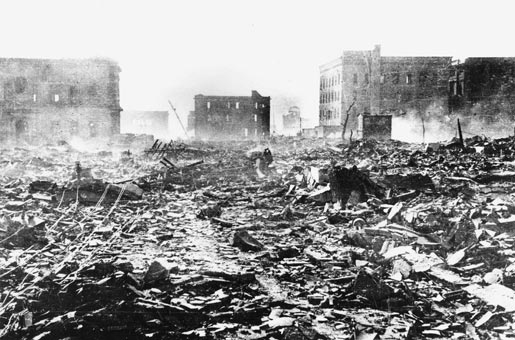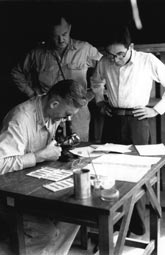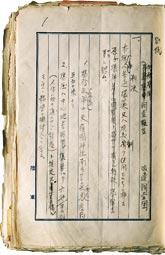The Dropping of the A-bomb and Survey Activities
On August 6, 1945, a single atomic bomb was dropped on Hiroshima. The city was instantly reduced to ruins and vast numbers of residents lost their lives.
Immediately after the bombing, relief activities were principally carried out by the Japanese military. Almost immediately, military personnel in Hiroshima were dispatched in survey teams to ascertain the nature of the bomb and the damage, then recommend countermeasures. Beginning on August 8, survey teams from the Cabinet, Imperial Headquarters, and university researchers commissioned by the Army and Navy were dispatched to Hiroshima where they measured radioactivity and in other ways sought to confirm that the new weapon was, indeed, an atomic bomb.

[6] |
[6]
Smoky ruins in downtown area
August 7, 1945 Harimaya-cho (now, Hondori)
490m from the hypocenter Photo by Mitsugi Kishida Courtesy of Teppei Kishida
The fires that erupted from the bomb reached a peak from about 10 a.m. to 2 to 3 p.m. on that same day, and continued to burn throughout the day. The area within a two-kilometer radius of the hypocenter was completely burned to ashes. |

[7] |
[7]
Study of atomic bomb's effects on humans by U.S. survey team
September 11, 1945 Ujina-machi (now, Ujina-higashi 5-chome)
Hiroshima First Army Hospital Ujina Branch
4,200m from the hypocenter Photo by Entaro Yamagami Courtesy of Mainichi Shimbun
The Manhattan Engineer District Investigating Group (U.S.) first entered the city of Hiroshima on September 9. The survey team, which included military doctors and military engineers, gathered a large amount of information aimed at confirming the safety of the bomb site and investigating the effects of the atomic bomb, particularly the effects of radiation. |

[8]
|
[8]
Draft of the Hiroshima Bombing Survey Report
Donated by Seiichi Niizuma
The results of investigations conducted to that point were examined. In the report the "judgment…concluding that it was an atomic bomb" was formally set forth for the first time. |



